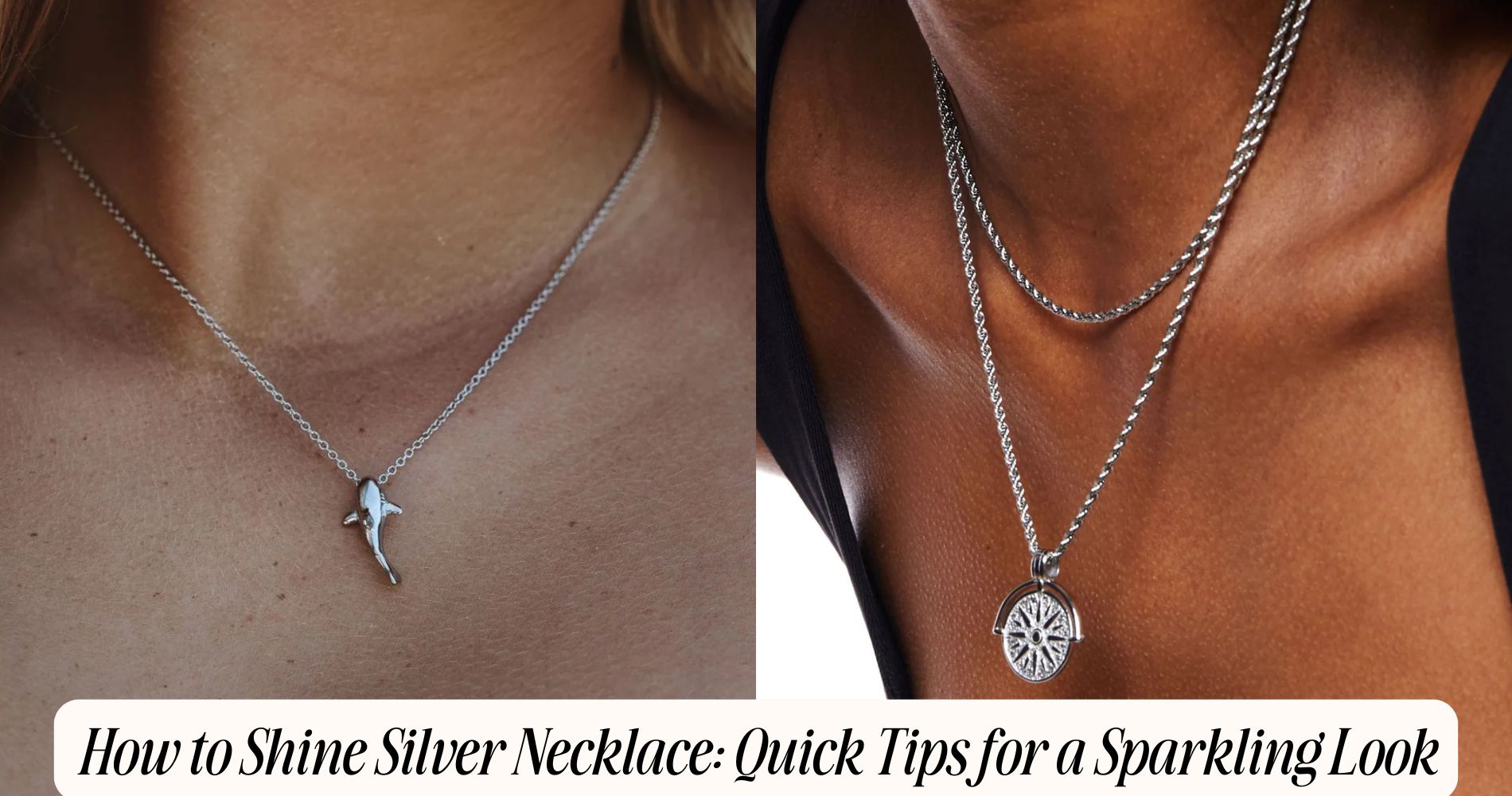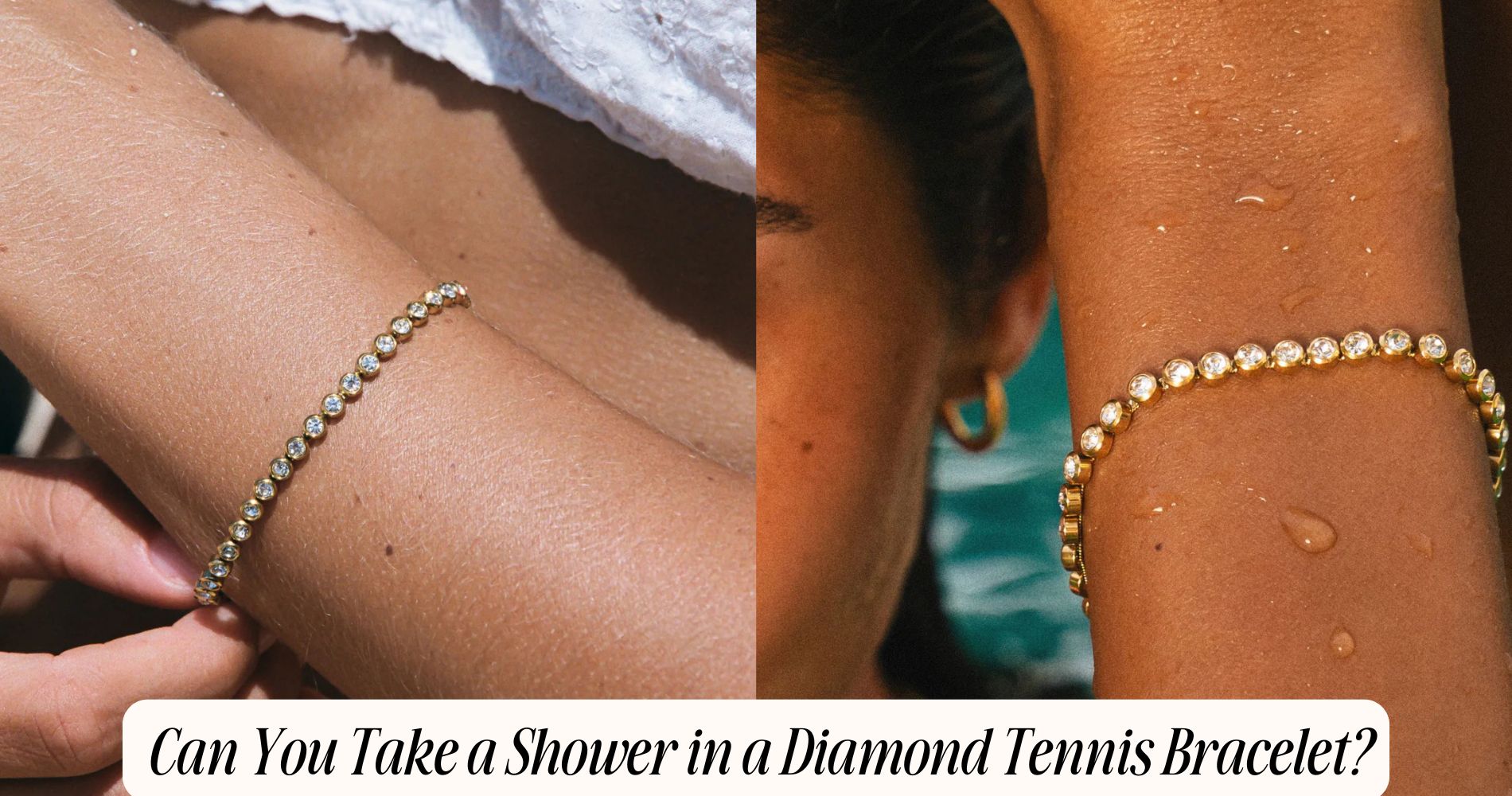
How to Shine Silver Necklace: Quick Tips for a Sparkling Look
If you're wondering how to shine silver necklace, start by cleaning it regularly. Mix equal parts of white vinegar and water, soak a soft cloth in it, then gently rub the necklace. Rinse thoroughly under lukewarm water. For extra shine, use a polishing cloth and apply cream polish in circular motions. Always store your necklace in a cool, dry place, preferably in an anti-tarnish pouch, to prevent tarnishing. Avoid contact with lotions and perfumes, and take it off while swimming or exercising. Follow these tips for a sparkling look, and if you're searching for inspiration, explore our Cute Silver Necklaces collection for stunning pieces you'll love.
Understanding Silver Tarnish
Over time, silver tarnishes due to a chemical reaction with sulfur and moisture in the air. This process creates a layer of tarnish that dulls the shine of your silver necklace. The primary tarnish causes include exposure to elements like air, humidity, and various household chemicals.
Even everyday activities, such as wearing perfume or lotion, can speed up tarnishing.
To keep your silver looking bright and shiny, you'll want to adopt some effective prevention methods. First, store your silver jewelry in a cool, dry place, ideally in anti-tarnish pouches or cloths. Limiting exposure to air and moisture can greatly slow down the tarnishing process.
Additionally, it's best to remove your necklace before engaging in activities that may introduce chemicals, like swimming or cleaning.
Regularly wearing your silver can actually help, as the friction can keep tarnish at bay. If you notice any tarnishing starting to develop, don't wait too long to address it.
Recognizing the tarnish causes and implementing these prevention methods will help maintain the beauty of your silver necklace, ensuring it stays a cherished accessory for years to come.
Household Cleaning Solutions
To restore the shine of your silver necklace, you can turn to common household cleaning solutions that are both effective and easy to use. One popular method is using a vinegar solution.
Mix equal parts of white vinegar and water in a bowl. Soak a soft cloth in the mixture, then gently rub your necklace to remove tarnish. Afterward, rinse it with clean water and pat it dry with a soft towel.
Another great option is toothpaste cleaning. Grab a non-gel toothpaste and apply a small amount to the tarnished areas of your necklace.
Use a soft toothbrush or a cloth to gently scrub the surface, focusing on any stubborn spots. Rinse the necklace thoroughly under lukewarm water to guarantee all toothpaste residue is removed, then dry it completely.
Both of these methods aren't only effective but also safe for your silver jewelry. They utilize items you likely already have at home, making them convenient choices for maintaining your silver's luster.
With a little effort and the right cleaning solutions, your necklace will shine like new in no time!
Using Silver Polish
When it comes to shining your silver necklace, choosing the right polish is essential.
You'll want to apply it properly to get the best results.
Let's explore how to select the perfect polish and the techniques for applying it effectively.
Choose the Right Polish
Selecting the right silver polish is vital for restoring your necklace's shine without causing damage. You'll find various silver polish types available, each designed for different needs. For general cleaning, consider a liquid polish, which is easy to apply and effective for most silver pieces.
If your necklace has intricate details or hard-to-reach areas, a cream polish might be better, as it provides a thicker consistency that clings to surfaces.
When choosing a polish, always check the label for any harsh chemicals that could harm your silver. Avoid any abrasive products, as they can scratch the surface and diminish the shine you're trying to achieve.
If your necklace has any gemstones or special finishes, verify the polish is safe for those materials as well.
Once you've selected the right product, familiarize yourself with the polish application. Following the manufacturer's instructions is vital for achieving the best results.
Application Techniques Explained
Applying silver polish requires a few simple techniques to assure your necklace regains its shine effectively.
Start by choosing a high-quality silver polish suitable for your necklace. Before you apply the polish, clean your necklace with a soft cloth to remove any dirt or oils.
Next, use a small amount of polish on a clean, soft cloth or a polishing pad. Gently rub the polish onto the silver in circular motions, focusing on tarnished areas. Be careful not to apply too much pressure, as this can scratch the surface.
Once you've polished your necklace, wipe off any excess polish with a fresh, dry cloth. This step assures that your necklace isn't left with a residue that could dull its shine.
As for cleaning frequency, aim to polish your silver necklace every few weeks, depending on how often you wear it. Regular maintenance using these polishing techniques will help keep your necklace looking sparkling and new.
Always remember to store your silver in a cool, dry place to minimize tarnishing, giving you more time between cleanings.
Soft Cloths for Cleaning
Using soft cloths for cleaning is essential to maintaining the shine of your silver necklace. When you choose the right cleaning materials, you'll notice a significant difference in the luster of your jewelry. Not all cloth types are suitable for silver, so it's important to select those specifically designed for this purpose.
Microfiber cloths are an excellent choice, as they're gentle yet effective at lifting tarnish without scratching the surface. You can also find polishing cloths that have a special inner layer designed to clean and a softer outer layer to buff your necklace to a high shine.
Avoid using paper towels or abrasive fabrics, as these can damage your silver. Instead, keep a dedicated soft cloth handy for cleaning whenever you wear your necklace.
Remember to gently wipe the necklace in a circular motion, focusing on areas where tarnish tends to build up.
Baking Soda Method
To clean your silver necklace using the baking soda method, you'll need a few supplies.
First, prepare a simple solution that will effectively tackle tarnish without damaging your jewelry.
Once you've cleaned it, don't forget to rinse and dry your necklace to bring back its shine.
Gather Your Supplies
Before you plunge into cleaning your silver necklace, you'll need to gather a few essential supplies for the baking soda method.
Start by creating a supplies checklist to guarantee you have everything you need. First up, grab a small bowl or dish where you can mix your cleaning solution. You'll also need baking soda, which is the star of this method, and water to activate it.
Next, don't forget about a soft cloth or microfiber towel. This essential tool will help you gently polish your necklace without scratching it. If your necklace has intricate details, consider having a soft-bristled toothbrush on hand; it's perfect for getting into those tiny crevices.
Lastly, you might want to have a pair of rubber gloves to protect your hands while you work.
With all these items ready to go, you're set to start the cleaning process. Remember, having your supplies organized makes it easier and more efficient when you're ready to shine your silver necklace.
Prepare the Solution
Preparing the cleaning solution is an essential step in restoring your silver necklace's shine. For the baking soda method, you'll need a simple combination of baking soda and water.
The common solution ratio is three parts baking soda to one part water. This means if you use three tablespoons of baking soda, mix it with one tablespoon of water.
You want to guarantee it forms a thick paste, so adjust the water slightly if needed. This baking soda paste acts as a powerful cleaner, effectively removing tarnish without scratching your silver.
Another solution type you can consider is using vinegar instead of water. For this, mix two parts baking soda with one part vinegar for an extra cleaning boost. Be cautious, though, as vinegar can be more abrasive.
Regardless of which solution you choose, make certain to mix it well until it's consistent.
Rinse and Dry
Once you've applied the baking soda paste to your silver necklace, it's crucial to rinse it off thoroughly.
Start by running your necklace under lukewarm water. Make sure all the paste is washed away, as any residue can cause tarnishing. Use your fingers to gently rub the surface while rinsing, ensuring you reach every nook and cranny.
Once it's clean, you'll want to dry it properly to prevent any water spots. You can use a soft, lint-free cloth to gently pat the necklace dry. Avoid using paper towels or rough fabrics, as these can scratch the silver.
For ideal shine, consider your cleaning frequency. If you wear your necklace often, cleaning it once a month can help maintain its sparkle. If you only wear it occasionally, every few months should suffice.
After drying, you can also use a polishing cloth for a final touch, enhancing its luster.
Lemon Juice and Olive Oil
If you're looking for a natural and effective way to clean your silver necklace, lemon juice and olive oil can work wonders. This simple mixture not only revives your jewelry's shine but also acts as a great solution for tarnish prevention.
To use this method, start by mixing equal parts of lemon juice and olive oil in a small bowl. The acidity of the lemon juice will cut through tarnish, while the olive oil provides a protective coating that helps keep your necklace looking shiny.
Take a soft cloth or a cotton ball, dip it into the mixture, and gently rub it over your necklace. Be sure to focus on any tarnished areas, as they may require a bit more attention.
After cleaning, rinse your necklace under lukewarm water to remove any residue, then dry it thoroughly with a soft cloth. This natural alternative not only keeps your necklace sparkling but also helps maintain its integrity over time.
Preventive Care Tips
To keep your silver necklace looking its best, regular preventive care is vital. Engaging in preventive maintenance can help you avoid tarnishing and dullness over time.
Start by establishing a routine cleaning schedule. Aim to clean your necklace once a month to remove dirt and oils that accumulate from wearing it.
When cleaning, use a soft cloth or a specialized silver polishing cloth to gently wipe away any grime. Avoid using harsh chemicals or abrasive materials, as these can scratch your necklace. If your necklace includes gemstones or delicate components, verify your cleaning method is safe for all materials involved.
Another significant aspect of preventive care is to be mindful of when you wear your necklace. Remove it before applying lotions, perfumes, or hair products, as these can contribute to tarnishing.
Additionally, avoid wearing your necklace during activities like swimming or exercising, where exposure to sweat and chlorine can cause damage.
Lastly, keep an eye on the condition of your necklace and address any signs of tarnish immediately. By following these preventive care tips, you'll maintain the beauty and shine of your silver necklace for years to come.
Storing Your Silver Necklace
Properly storing your silver necklace can make a significant difference in maintaining its shine and preventing tarnish. To achieve this, you should always prioritize proper storage methods.
Start by keeping your necklace in a cool, dry place away from direct sunlight. Excessive heat and humidity can accelerate tarnishing, so a stable environment is essential.
Using protective pouches is another effective strategy. Consider investing in anti-tarnish pouches or soft fabric bags, as they provide a barrier against the elements that cause tarnish. When you're not wearing your necklace, gently wrap it in a protective pouch to minimize exposure to air and moisture.
Avoid storing your silver necklace in a jewelry box with other pieces, as friction can lead to scratches. Instead, designate a specific spot for it, ensuring it's laid flat or hung to prevent tangling.
If you have multiple necklaces, you might also use individual pouches or compartments for each piece.
When to Seek Professional Help
Even with careful storage, there are times when your silver necklace might need professional attention. If you notice signs of tarnish that just won't budge, it's a clear indicator that you should seek help. Discoloration, dark spots, or a dull finish can be frustrating, especially if your DIY cleaning methods haven't worked.
When your necklace starts losing its luster despite your efforts, it's time to reflect on professional cleaning. Jewelers have specialized tools and products that can restore your necklace to its original shine without causing damage. Additionally, if your necklace has intricate designs or embedded stones, a professional can guarantee those areas are safely and effectively cleaned.
Another reason to seek expert help is if your necklace has sustained some physical damage. A broken clasp or a bent chain needs skilled hands to repair it properly.
Don't hesitate to consult a professional when you notice these signs; it'll save you time and guarantee your treasured piece remains in excellent condition. Remember, investing in professional cleaning can prolong the life of your silver necklace, giving it the sparkle you love.
Frequently Asked Questions
Can I Use Toothpaste to Clean My Silver Necklace?
You can use toothpaste to clean your silver necklace, but its effectiveness might vary. Consider silver cleaning alternatives like baking soda or dedicated silver polish for better results and to avoid potential damage to your jewelry.
How Often Should I Clean My Silver Jewelry?
You should clean your silver jewelry regularly, ideally every few weeks, to maintain its shine and prevent tarnish. Establishing a cleaning frequency helps keep your pieces looking beautiful and extends their lifespan.
Are There Any Tools I Should Avoid Using on Silver?
When cleaning silver, avoid abrasive materials and harsh chemicals. Stick to gentle silver cleaning methods and use soft silver polishing cloths to maintain your jewelry's shine without risking scratches or damage. Keep it sparkling safely!
Does Wearing Silver Jewelry Cause Skin Reactions?
Wearing silver jewelry can cause skin reactions for some, especially if you have skin sensitivity. Consider hypoallergenic options to minimize irritation and enjoy your jewelry without discomfort. Always test new pieces before regular wear.
Can Silver Jewelry Be Repaired if Damaged?
Yes, you can repair damaged silver jewelry. Utilizing silver restoration techniques and practicing regular silver jewelry maintenance guarantees your pieces remain beautiful. Don't hesitate to consult a professional for more extensive repairs or intricate designs.
Conclusion
By following these quick tips, you can keep your silver necklace sparkling and tarnish-free. Regular cleaning with household solutions or silver polish makes a big difference, and using soft cloths will prevent scratches. Don't forget to store your necklace properly and take preventive care to maintain its shine. If you ever find yourself overwhelmed by tarnish, don't hesitate to seek professional help. With a little effort, your silver can always look its best!
























Leave a comment
This site is protected by hCaptcha and the hCaptcha Privacy Policy and Terms of Service apply.